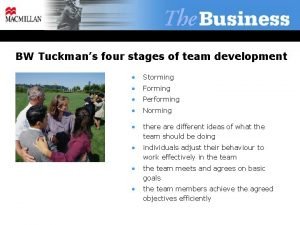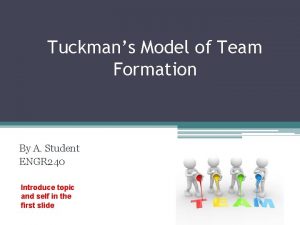Tuckmans Team Development Model Stage 1 Forming Stage


- Slides: 2

Tuckman’s Team Development Model Stage 1 - Forming Stage 2 – Storming The formation of a group. Dependent on the leader unsure of each other and themselves, look for guidance, need to know they’re safe. Seriousness is avoided Competitive, vying to be a standout. The team is unsure of one another, project clarity begins to develop but there is still a great deal of uncertainty. The leader is the coach and is needed for progress and direction. Stage 3 – Norming Stage 4 – Performing The team is coming together as a group with a sense of unity and commitment. The team discusses and moves forward together towards their goal. The leader has now become a facilitator. There is a clear purpose and the team is working collectively to reach the goal. Everyone knows what is expected of them and they are working to meet the goal as a team with no interference from the leader. The leader delegates and oversees the situation. Stage 5 – Adjourning The goal has been reached and the everyone can go move on. This stage is about decompressing, and letting go as a team after working together for so long C. Gove- AL Nov. 21, 2014

http: //tep. uoregon. edu/showcase/crmodel/strategies/basic_group_theory. html http: //www. washington. edu/research/rapid/resources/change. Models/mc_team_development. pdf https: //www. youtube. com/watch? v=Oh. SI 6 o. BQm. QA Dysfunctional Team Scenario • A team has been created which is comprised of people from several different departments to brainstorm and come up with a solution to resolve the lack of backup documentation attached to documents needing approving. The leader has carefully been selected and the group is diverse and also consists of people from the department which needs revision. Those people are not happy because they are opposed to change. The rest of the group each wants their ideas heard but doesn’t completely understand what the task involves and how to make the task the most efficient for all. Everyone is at odds and wants things done a certain way, each person digging their heels in as to why their way would work best. • If they followed the Tuckmans Development Model, the leader would have done a better job guiding and directing and clarifying the goal supporting the Forming and Storming part of the Model. When they hit Norming, they would each understand the plan and try and come up with how they would bring this to fruition with the leader being the facilitator. By the time they got to Performing, they would understand all and have a “Green” and efficient solution that would work for everyone. The task would be laid out and ready for implementation. • The Adjourning would be a last meeting after implementation, recognizing how well the system works and complimenting everyone for their effort and contribution. • This was an actual problem which turned into a power struggle. Unfortunately, it did not resolve itself in the above mentioned manner and turned out to be more of an armtwisting with not everyone being happy about the outcome. The outcome would have needed to have been the same in the end, but if there was more structure there may have been happier players and more willing to work together in the future. Instead it probably created more of a wedge and employee unhappiness.


